Jing Huang
Hierarchical Deformation Planning and Neural Tracking for DLOs in Constrained Environments
Dec 31, 2025Abstract:Deformable linear objects (DLOs) manipulation presents significant challenges due to DLOs' inherent high-dimensional state space and complex deformation dynamics. The wide-populated obstacles in realistic workspaces further complicate DLO manipulation, necessitating efficient deformation planning and robust deformation tracking. In this work, we propose a novel framework for DLO manipulation in constrained environments. This framework combines hierarchical deformation planning with neural tracking, ensuring reliable performance in both global deformation synthesis and local deformation tracking. Specifically, the deformation planner begins by generating a spatial path set that inherently satisfies the homotopic constraints associated with DLO keypoint paths. Next, a path-set-guided optimization method is applied to synthesize an optimal temporal deformation sequence for the DLO. In manipulation execution, a neural model predictive control approach, leveraging a data-driven deformation model, is designed to accurately track the planned DLO deformation sequence. The effectiveness of the proposed framework is validated in extensive constrained DLO manipulation tasks.
Eliciting Behaviors in Multi-Turn Conversations
Dec 29, 2025Abstract:Identifying specific and often complex behaviors from large language models (LLMs) in conversational settings is crucial for their evaluation. Recent work proposes novel techniques to find natural language prompts that induce specific behaviors from a target model, yet they are mainly studied in single-turn settings. In this work, we study behavior elicitation in the context of multi-turn conversations. We first offer an analytical framework that categorizes existing methods into three families based on their interactions with the target model: those that use only prior knowledge, those that use offline interactions, and those that learn from online interactions. We then introduce a generalized multi-turn formulation of the online method, unifying single-turn and multi-turn elicitation. We evaluate all three families of methods on automatically generating multi-turn test cases. We investigate the efficiency of these approaches by analyzing the trade-off between the query budget, i.e., the number of interactions with the target model, and the success rate, i.e., the discovery rate of behavior-eliciting inputs. We find that online methods can achieve an average success rate of 45/19/77% with just a few thousand queries over three tasks where static methods from existing multi-turn conversation benchmarks find few or even no failure cases. Our work highlights a novel application of behavior elicitation methods in multi-turn conversation evaluation and the need for the community to move towards dynamic benchmarks.
LogicLens: Visual-Logical Co-Reasoning for Text-Centric Forgery Analysis
Dec 25, 2025Abstract:Sophisticated text-centric forgeries, fueled by rapid AIGC advancements, pose a significant threat to societal security and information authenticity. Current methods for text-centric forgery analysis are often limited to coarse-grained visual analysis and lack the capacity for sophisticated reasoning. Moreover, they typically treat detection, grounding, and explanation as discrete sub-tasks, overlooking their intrinsic relationships for holistic performance enhancement. To address these challenges, we introduce LogicLens, a unified framework for Visual-Textual Co-reasoning that reformulates these objectives into a joint task. The deep reasoning of LogicLens is powered by our novel Cross-Cues-aware Chain of Thought (CCT) mechanism, which iteratively cross-validates visual cues against textual logic. To ensure robust alignment across all tasks, we further propose a weighted multi-task reward function for GRPO-based optimization. Complementing this framework, we first designed the PR$^2$ (Perceiver, Reasoner, Reviewer) pipeline, a hierarchical and iterative multi-agent system that generates high-quality, cognitively-aligned annotations. Then, we constructed RealText, a diverse dataset comprising 5,397 images with fine-grained annotations, including textual explanations, pixel-level segmentation, and authenticity labels for model training. Extensive experiments demonstrate the superiority of LogicLens across multiple benchmarks. In a zero-shot evaluation on T-IC13, it surpasses the specialized framework by 41.4% and GPT-4o by 23.4% in macro-average F1 score. Moreover, on the challenging dense-text T-SROIE dataset, it establishes a significant lead over other MLLM-based methods in mF1, CSS, and the macro-average F1. Our dataset, model, and code will be made publicly available.
SiamMM: A Mixture Model Perspective on Deep Unsupervised Learning
Nov 07, 2025Abstract:Recent studies have demonstrated the effectiveness of clustering-based approaches for self-supervised and unsupervised learning. However, the application of clustering is often heuristic, and the optimal methodology remains unclear. In this work, we establish connections between these unsupervised clustering methods and classical mixture models from statistics. Through this framework, we demonstrate significant enhancements to these clustering methods, leading to the development of a novel model named SiamMM. Our method attains state-of-the-art performance across various self-supervised learning benchmarks. Inspection of the learned clusters reveals a strong resemblance to unseen ground truth labels, uncovering potential instances of mislabeling.
See, Think, Act: Online Shopper Behavior Simulation with VLM Agents
Oct 22, 2025Abstract:LLMs have recently demonstrated strong potential in simulating online shopper behavior. Prior work has improved action prediction by applying SFT on action traces with LLM-generated rationales, and by leveraging RL to further enhance reasoning capabilities. Despite these advances, current approaches rely on text-based inputs and overlook the essential role of visual perception in shaping human decision-making during web GUI interactions. In this paper, we investigate the integration of visual information, specifically webpage screenshots, into behavior simulation via VLMs, leveraging OPeRA dataset. By grounding agent decision-making in both textual and visual modalities, we aim to narrow the gap between synthetic agents and real-world users, thereby enabling more cognitively aligned simulations of online shopping behavior. Specifically, we employ SFT for joint action prediction and rationale generation, conditioning on the full interaction context, which comprises action history, past HTML observations, and the current webpage screenshot. To further enhance reasoning capabilities, we integrate RL with a hierarchical reward structure, scaled by a difficulty-aware factor that prioritizes challenging decision points. Empirically, our studies show that incorporating visual grounding yields substantial gains: the combination of text and image inputs improves exact match accuracy by more than 6% over text-only inputs. These results indicate that multi-modal grounding not only boosts predictive accuracy but also enhances simulation fidelity in visually complex environments, which captures nuances of human attention and decision-making that text-only agents often miss. Finally, we revisit the design space of behavior simulation frameworks, identify key methodological limitations, and propose future research directions toward building efficient and effective human behavior simulators.
Customer-R1: Personalized Simulation of Human Behaviors via RL-based LLM Agent in Online Shopping
Oct 08, 2025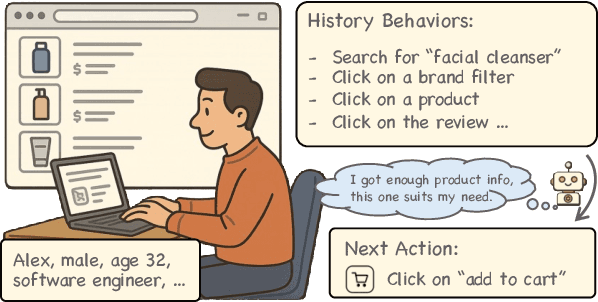


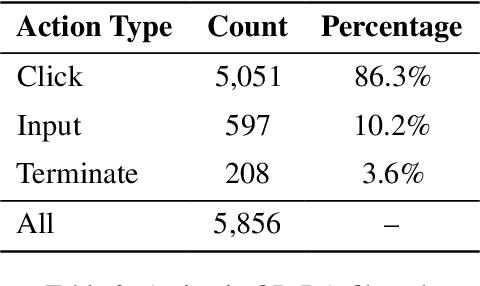
Abstract:Simulating step-wise human behavior with Large Language Models (LLMs) has become an emerging research direction, enabling applications in various practical domains. While prior methods, including prompting, supervised fine-tuning (SFT), and reinforcement learning (RL), have shown promise in modeling step-wise behavior, they primarily learn a population-level policy without conditioning on a user's persona, yielding generic rather than personalized simulations. In this work, we pose a critical question: how can LLM agents better simulate personalized user behavior? We introduce Customer-R1, an RL-based method for personalized, step-wise user behavior simulation in online shopping environments. Our policy is conditioned on an explicit persona, and we optimize next-step rationale and action generation via action correctness reward signals. Experiments on the OPeRA dataset emonstrate that Customer-R1 not only significantly outperforms prompting and SFT-based baselines in next-action prediction tasks, but also better matches users' action distribution, indicating higher fidelity in personalized behavior simulation.
Beyond Correctness: Harmonizing Process and Outcome Rewards through RL Training
Sep 03, 2025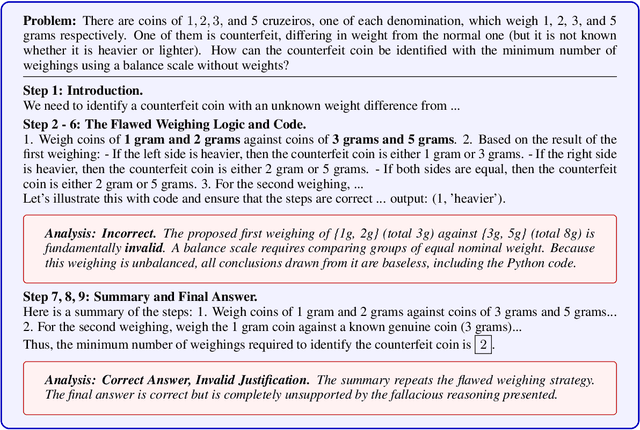



Abstract:Reinforcement learning with verifiable rewards (RLVR) has emerged to be a predominant paradigm for mathematical reasoning tasks, offering stable improvements in reasoning ability. However, Outcome Reward Models (ORMs) in RLVR are too coarse-grained to distinguish flawed reasoning within correct answers or valid reasoning within incorrect answers. This lack of granularity introduces noisy and misleading gradients significantly and hinders further progress in reasoning process quality. While Process Reward Models (PRMs) offer fine-grained guidance for intermediate steps, they frequently suffer from inaccuracies and are susceptible to reward hacking. To resolve this dilemma, we introduce PRocess cOnsistency Filter (PROF), an effective data process curation method that harmonizes noisy, fine-grained process rewards with accurate, coarse-grained outcome rewards. Rather than naively blending PRM and ORM in the objective function (arXiv:archive/2506.18896), PROF leverages their complementary strengths through consistency-driven sample selection. Our approach retains correct responses with higher averaged process values and incorrect responses with lower averaged process values, while maintaining positive/negative training sample balance. Extensive experiments demonstrate that our method not only consistently improves the final accuracy over $4\%$ compared to the blending approaches, but also strengthens the quality of intermediate reasoning steps. Codes and training recipes are available at https://github.com/Chenluye99/PROF.
UItron: Foundational GUI Agent with Advanced Perception and Planning
Aug 29, 2025Abstract:GUI agent aims to enable automated operations on Mobile/PC devices, which is an important task toward achieving artificial general intelligence. The rapid advancement of VLMs accelerates the development of GUI agents, owing to their powerful capabilities in visual understanding and task planning. However, building a GUI agent remains a challenging task due to the scarcity of operation trajectories, the availability of interactive infrastructure, and the limitation of initial capabilities in foundation models. In this work, we introduce UItron, an open-source foundational model for automatic GUI agents, featuring advanced GUI perception, grounding, and planning capabilities. UItron highlights the necessity of systemic data engineering and interactive infrastructure as foundational components for advancing GUI agent development. It not only systematically studies a series of data engineering strategies to enhance training effects, but also establishes an interactive environment connecting both Mobile and PC devices. In training, UItron adopts supervised finetuning over perception and planning tasks in various GUI scenarios, and then develop a curriculum reinforcement learning framework to enable complex reasoning and exploration for online environments. As a result, UItron achieves superior performance in benchmarks of GUI perception, grounding, and planning. In particular, UItron highlights the interaction proficiency with top-tier Chinese mobile APPs, as we identified a general lack of Chinese capabilities even in state-of-the-art solutions. To this end, we manually collect over one million steps of operation trajectories across the top 100 most popular apps, and build the offline and online agent evaluation environments. Experimental results demonstrate that UItron achieves significant progress in Chinese app scenarios, propelling GUI agents one step closer to real-world application.
DyCrowd: Towards Dynamic Crowd Reconstruction from a Large-scene Video
Aug 18, 2025Abstract:3D reconstruction of dynamic crowds in large scenes has become increasingly important for applications such as city surveillance and crowd analysis. However, current works attempt to reconstruct 3D crowds from a static image, causing a lack of temporal consistency and inability to alleviate the typical impact caused by occlusions. In this paper, we propose DyCrowd, the first framework for spatio-temporally consistent 3D reconstruction of hundreds of individuals' poses, positions and shapes from a large-scene video. We design a coarse-to-fine group-guided motion optimization strategy for occlusion-robust crowd reconstruction in large scenes. To address temporal instability and severe occlusions, we further incorporate a VAE (Variational Autoencoder)-based human motion prior along with a segment-level group-guided optimization. The core of our strategy leverages collective crowd behavior to address long-term dynamic occlusions. By jointly optimizing the motion sequences of individuals with similar motion segments and combining this with the proposed Asynchronous Motion Consistency (AMC) loss, we enable high-quality unoccluded motion segments to guide the motion recovery of occluded ones, ensuring robust and plausible motion recovery even in the presence of temporal desynchronization and rhythmic inconsistencies. Additionally, in order to fill the gap of no existing well-annotated large-scene video dataset, we contribute a virtual benchmark dataset, VirtualCrowd, for evaluating dynamic crowd reconstruction from large-scene videos. Experimental results demonstrate that the proposed method achieves state-of-the-art performance in the large-scene dynamic crowd reconstruction task. The code and dataset will be available for research purposes.
DocTron-Formula: Generalized Formula Recognition in Complex and Structured Scenarios
Aug 01, 2025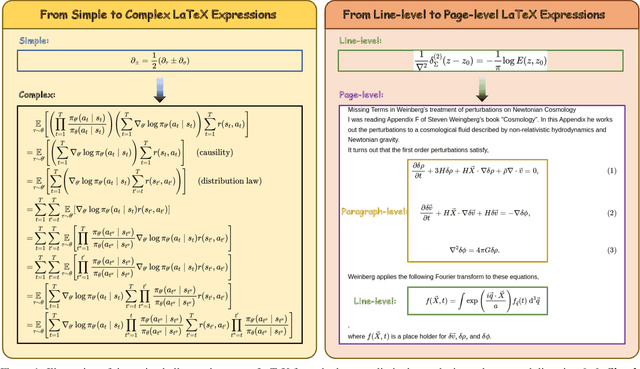


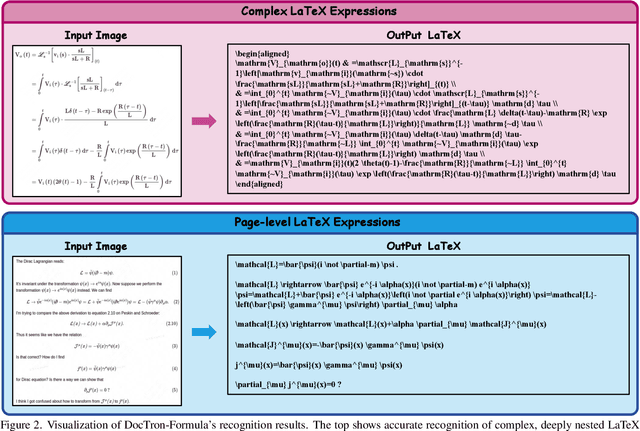
Abstract:Optical Character Recognition (OCR) for mathematical formula is essential for the intelligent analysis of scientific literature. However, both task-specific and general vision-language models often struggle to handle the structural diversity, complexity, and real-world variability inherent in mathematical content. In this work, we present DocTron-Formula, a unified framework built upon general vision-language models, thereby eliminating the need for specialized architectures. Furthermore, we introduce CSFormula, a large-scale and challenging dataset that encompasses multidisciplinary and structurally complex formulas at the line, paragraph, and page levels. Through straightforward supervised fine-tuning, our approach achieves state-of-the-art performance across a variety of styles, scientific domains, and complex layouts. Experimental results demonstrate that our method not only surpasses specialized models in terms of accuracy and robustness, but also establishes a new paradigm for the automated understanding of complex scientific documents.
 Add to Chrome
Add to Chrome Add to Firefox
Add to Firefox Add to Edge
Add to Edge